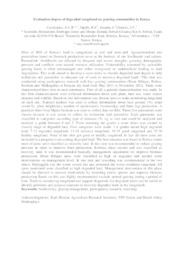Evaluation degree of degraded rangeland on grazing communities in Kenya.
Evaluation degree of degraded rangeland on grazing communities in Kenya.
Autoria: CAVALCANTE, A. C. R.; OGILLO, B. P.; AKUMU, J.; GLUECKS, I. V.
Resumo: Most of 80% of Kenya´s land is categorized as arid and semi-arid. Agropastoralism and pastoralism based on livestock production serve as the bedrock of site livelihoods and culture. Pastoralists? livelihoods are affected by frequent and severe droughts, growing demographic pressure and conflicts over natural resource utilization. Vulnerability worsened by accessible grazing lands is often mismanaged and either overgrazed or underutilized leading to land degradation. This work aimed to develop a score index to classify degraded land degree to help technician and pastoralist in adequate use of tools to recovery degraded lands. This trial was conducted using participatory research with four grazing communities (Bisan Biliquo, Bulesa, Korbesa and Malkagalla) in Kenyan dry land from May 2011 to November 2012. There were characterized three sites in each community. First of all, a general characterization was made. In this first characterization were collected information about soil, plant, land use, water source distance and wildlife. Based on this information was chosen spots to make monitoring rangeland on each site. Transect method was used to collect information about bare ground (%), plant cover(%), plant height(cm), number of species(unit), biomass(kg) and litter (kg) production. A practical sheet from Mpala Institute was used to collect data on field. These five parameters were chosen because it was easier to collect by technician and pastoralist. Each parameter was classified in categories according type of measure (%, kg or cm) and could be analyzed and received a grade between 0 and 5. From summing the grades a score index was created to classify stage of degraded land. Five categories were made: 1-6 grades meant high degraded land; 7-12 degraded rangeland; 13-18 recovery rangeland; 19-24 good rangeland and 25-30 healthy rangeland. None of the sites got good or healthy rangeland. In fact all these areas are included in a program to recovering degraded land. The best situation was found in Bulesa where most of areas were classified as recovery land. In this case was recommended to reduce grazing pressure in order to improve litter production. Korbesa place second and was classified as recovery land. It was recommended basically management adjustment for improve biomass production. Bisan Biliquo areas were classified as high or degraded and needed some interventions on management level. In one spot and reseeding was recommended in the two others. Malkagalla was the worse scored site and presented the worse condition rangeland. All spots monitored were classified as high degraded land. Management intervention in this place should be directed to recover biodiversity by reseeding native species and improve biomass production Based on this was highly recommended exclude animal grazing during a period of time. Tools to monitoring rangeland and support diagnostic for degraded lands can be useful to identify problems and propose solutions to recovery degraded lands in dry rangelands.
Ano de publicação: 2013
Tipo de publicação: Resumo em anais e proceedings
Unidade: Embrapa Caprinos e Ovinos
Observações
1 - Por padrão são exibidas publicações dos últimos 20 anos. Para encontrar publicações mais antigas, configure o filtro ano de publicação, colocando o ano a partir do qual você deseja encontrar publicações. O filtro está na coluna da esquerda na busca acima.
2 - Para ler algumas publicações da Embrapa (apenas as que estão em formato ePub), é necessário ter, no celular ou computador, um desses softwares gratuitos. Sistemas Android: Google Play Livros; IOS: iBooks; Windows e Linux: software Calibre.
Acesse outras publicações
Acesse a Base de Dados da Pesquisa Agropecuária (BDPA) para consultar o acervo completo das bibliotecas da Embrapa.

